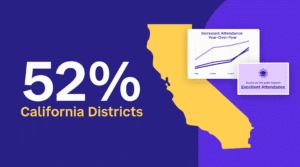
Featured Resource
Why Over Half of California School Districts Trust SchoolStatus
Read More >Join Mission: Attendance to reduce chronic absenteeism in 2025-26! >> Learn How <<






Lindsey Frank, M.Ed., a district-wide Climate and Social-Emotional Learning Coach in Illinois, shares strategies for embedding social and emotional learning into your coaching partnerships, especially within remote learning spaces.
S
chool districts worldwide have infused social and emotional learning (SEL) into instruction for some time, but recently have made a larger push recently as a way to help address the global trauma of the COVID-19 pandemic and to support the switch to digital learning environments.
First, what is it! SEL addresses five main areas—along with learning standards—called the CASEL Core Competencies. These competencies are: Relationship Skills, Self-Awareness, Self-Management, Social Awareness, and Responsible Decision-Making. Each competency is interwoven, creating connections for students.
More specifically, SEL is a set of explicitly taught skills that are designed to meet the needs of students based on observable data, just like in content areas. They create a lasting impact on a learner’s life. It’s not “fluff,” it’s not “extra,” and it’s not “filler.” If you’re just setting out in this work, or searching for where to begin, let your journey begin here!

SEL is a great coaching tool to add to your ever-growing toolkit!
While remote learning creates many of its own challenges, SEL skills are just as important in online environments. Below are the top three focus areas to develop SEL skills in online learning spaces—plus considerations and coaching ideas for teachers.
Developing relationships is always at the heart of teaching. With virtual learning spaces, every interaction needs to be intentional, and this includes the relationship with families. Partner with teachers to establish positive relationships, using some of these ideas:
Within the online learning space, it can be easy to feel a relationship overload. This is when teachers feel completely overloaded with the desire for relationships, yet struggle to find ways of making it authentic. In response, they may increase the focus to an extreme level causing stress just thinking about relationships. Teachers (and coaches) may find themselves overextending within their relationships—that 10:00 PM parent email response, the working lunch, breakfast, and dinner.
With the opposite lens, you may have limited communication because reaching out to families may step you out of your comfort zone or the limited engagement that you are receiving from families may leave you feeling defeated. The final relationship layer to consider is the increased opportunities for cyber-bullying, even during class with the private chat features.
Students come from all different environments. With online spaces, support partnerships in creating positive classroom agreements so that students feel comfortable showing their true self. Teach learners how they can create spaces at home to support their learning.
Keep in mind that teachers may place their values on their students by requiring cameras on or off which can result in emotional reactions. Students may live in unique conditions and may not want to participate in certain ways. It’s important to honor their preferences. Be aware that siblings may distract each other or that other responsibilities may be given to the student which can impact their learning at home.
When learning online, students need to learn how to budget their time, how to arrive to class and breakout sessions on time, and even how to use alarms and calendars. These coaching ideas can help:
Remember that norms for time management may differ within cultures and even planforms, for example “on time” online means right on time, while in person “on time” may mean several minutes early.
Students may have a limited concept of time, with not all students being able to tell time. It’s also worth considering the developmentally appropriate levels of time management.
Now that we’ve shared three targeted SEL skills for remote learning, let’s take a look at how you can reflect on SEL more broadly.
Picture a math lesson where students are collaborating together to explain their mathematical thinking with several different answers. Read the question below, and take a moment to write down your ideas.
What SEL skills do students
need to have or need to learn within your content lesson?
The skills you wrote down might include: listening, working in groups, sharing your thoughts, disagreeing respectfully, turn-taking, giving feedback, accepting feedback, and so on. I’d encourage you to reflect on your current coaching cycles, and consider what skills students might need, as this is key to embedding SEL in instruction.
Following a prescribed SEL curriculum sequentially and specifically addressing the needs of learners in the classroom has a place, however with Tier 1 I advocate for purposefully tailored SEL instruction that matches the needs of the students in the classroom. Here’s how:
Feel free to use the tools and examples above to help you create authentic and meaningful experiences for your learners and teachers. Remember, SEL are explicitly taught skills, not just told to students!
The most impactful SEL starts with you and your own social and emotional foundation. Whatever your role, students’ nervous systems reflect your own nervous system.
When we can embody and model SEL skills for learners, we can help them grow and become more resilient. Echo this with your partnerships and work together as a support system, no matter the world situation. In-person, or online—we’ve got this!
Lindsey J. Frank, M.Ed. is a district-wide Climate and Social-Emotional Learning Coach in Illinois, reaching students from pre-k to eighth grade. She is the author of the children’s book Big Change, Better You, Beautiful World. Her master’s is in Educational Leadership in Administration and Supervision. Prior to her current role, Lindsey was a K-8 interventionist and guided reading teacher, a 7th grade pre-algebra teacher, and taught diverse learners in a resource setting.
Lindsey is also a certified yoga instructor with additional certifications in trauma-informed yoga and children’s yoga. She serves as a Regional Director for the Coalition of Schools Educating Mindfully (COSEM) and is a Local Chapter Facilitator for the Northwest Suburban COSEM Chapter in Illinois.
Be sure to check out Lindsey’s website, read her published chapter in Educating Mindfully: Stories of School Transformation Through Mindfulness, and connect with her on Facebook, Instagram, and Twitter!
{{cta(‘352a410e-db79-4f33-a482-d301e8041965′,’justifycenter’)}}
Graphics from Mixkit.
 SchoolStatusSchoolStatus gives educators the clarity and tools they need to get students to class and keep them moving ahead. Through our integrated suite of data-driven products, we help districts spot attendance patterns early, reach families in ways that work for them, and support teacher growth with meaningful feedback. Our solutions include automated attendance interventions, multi-channel family communications in 130+ languages, educator development and coaching, streamlined digital workflows, and engaging school websites. Serving over 22 million students across thousands of districts in all 50 states, SchoolStatus helps teachers and staff see what matters, act with speed, and stay focused on students.
SchoolStatusSchoolStatus gives educators the clarity and tools they need to get students to class and keep them moving ahead. Through our integrated suite of data-driven products, we help districts spot attendance patterns early, reach families in ways that work for them, and support teacher growth with meaningful feedback. Our solutions include automated attendance interventions, multi-channel family communications in 130+ languages, educator development and coaching, streamlined digital workflows, and engaging school websites. Serving over 22 million students across thousands of districts in all 50 states, SchoolStatus helps teachers and staff see what matters, act with speed, and stay focused on students.
News, articles, and tips for meeting your district’s goals—delivered to your inbox.






